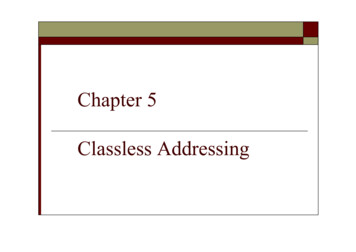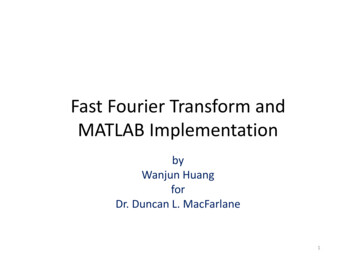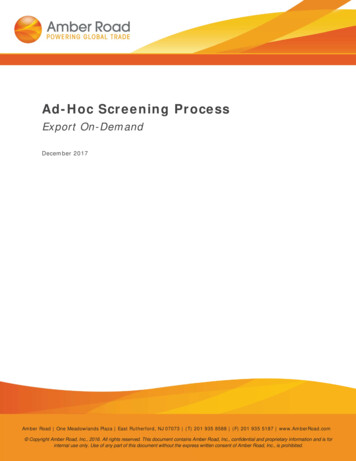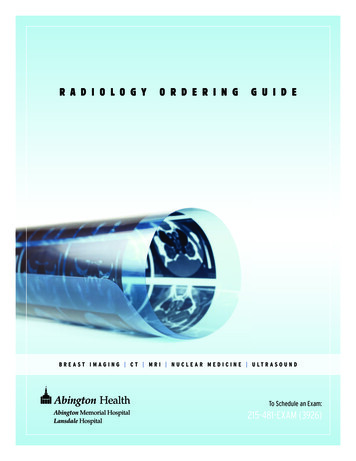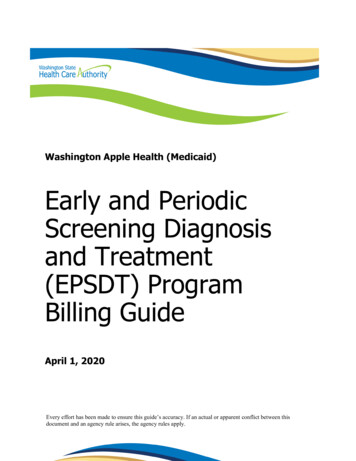
Transcription
Washington Apple Health (Medicaid)Early and PeriodicScreening Diagnosisand Treatment(EPSDT) ProgramBilling GuideApril 1, 2020Every effort has been made to ensure this guide’s accuracy. If an actual or apparent conflict between thisdocument and an agency rule arises, the agency rules apply.
Early and Periodic ScreeningDiagnosis and Treatment (EPSDT) ProgramAbout this guide*This publication takes effect April 1, 2020, and supersedes earlier guides to this program.HCA is committed to providing equal access to our services. If you need an accommodation orhave a speech disability, please call 711 for relay services.Washington Apple Health means the public health insurance programs for eligibleWashington residents. Washington Apple Health is the name used in WashingtonState for Medicaid, the children's health insurance program (CHIP), and stateonly funded health care programs. Washington Apple Health is administered bythe Washington State Health Care Authority.What has changed?SubjectChangeDepression ScreeningUpdated language to say “the agencycovers one structured depressionscreening every year for children age 12and older.”Clarification of lead screeningrequirements.Lead ScreeningReason for ChangeClarification.To align with federalmandate.How can I get agency provider documents?To access provider alerts, go to the agency’s provider alerts webpage.To access provider documents, go to the agency’s provider billing guides and fee scheduleswebpage.*This publication is a billing instruction.2
Early and Periodic ScreeningDiagnosis and Treatment (EPSDT) ProgramWhere can I download agency forms?To download an agency provider form, go to HCA’s Billers and provider’s webpage, selectForms & publications. Type the HCA form number into the Search box as shown below(Example: 13-835).Copyright disclosureCurrent Procedural Terminology (CPT) copyright 2019 AmericanMedical Association (AMA). All rights reserved. CPT is aregistered trademark of the American Medical Association.Fee schedules, relative value units, conversion factors or relatedcomponents, or both, are not assigned by the AMA, are not part ofCPT, and the AMA is not recommending their use. The AMA doesnot directly or indirectly practice medicine or dispense medicalservices. The AMA assumes no liability for data contained or notcontained herein.3
Early and Periodic ScreeningDiagnosis and Treatment (EPSDT) ProgramTable of ContentsResources Available .6Program Overview .7Who can provide EPSDT well-child checkups? .7Is transportation to and from EPSDT well-child checkups available? .7Pediatric primary care rate increase .8Client Eligibility .9How do I verify a client’s eligibility? .9Who is eligible for EPSDT well-child checkups? .10What if an infant has not yet been assigned a ProviderOne Client ID? .10Are managed care clients eligible for EPSDT well-child checkups? .11Managed care enrollment .12Apple Health – Changes for January 1, 2020 .12Clients who are not enrolled in an agency-contracted managed care plan forphysical health services.13Integrated managed care (IMC) .13Integrated Apple Health Foster Care (AHFC) .15EPSDT Well-Child Checkups .16What is an EPSDT well-child checkup? .16Elements of EPSDT well-child checkup.17What are the time limits for scheduling requests for EPSDT well-child checkups? .23What if a problem is identified during an EPSDT well-child checkup?.24What is the periodicity schedule? .25EPSDT and Foster Care .30What do I need to know about EPSDT for children in foster care? .30How often can a child in foster care have an EPSDT well-child checkup? .31How can I identify a child in foster care placement?.31How do I bill EPSDT well-child checkups to receive the enhanced rate? .32What is an initial health evaluation (IHE) and how is it billed? .32What is included in an IHE? .32Can I bill for both an EPSDT well-child checkup and an IHE? .32Developmental and Behavioral Health Screening .33Is developmental screening part of the EPSDT well-child checkup process? .33Is behavioral health screening part of the EPSDT well-child checkup process? .33Screening guidelines .34Urgent referrals .34Non-urgent referral .35Alert! This Table of Contents is automated. Click on a page number to go directly to the page.4
Early and Periodic ScreeningDiagnosis and Treatment (EPSDT) ProgramHow are substance use screening and treatment provided? .35Screening, Brief Intervention, and Referral to Treatment (SBIRT) .35Washington Recovery Help Line .36Recommended screening tools .37EPSDT mental health/substance use assessment referral indicators .44Immunizations .46How do I bill for vaccines when clients are age 19 and 20?.46What vaccines are free from the Department of Health (DOH) for clients age 18 andyounger? .46General Authorization .48What is prior authorization (PA)? .48What is a limitation extension (LE)? .48How do I obtain authorization?.48Billing .49How do I bill claims electronically? .49What are the billing requirements specific to EPSDT? .49Alert! This Table of Contents is automated. Click on a page number to go directly to the page.5
Early and Periodic ScreeningDiagnosis and Treatment (EPSDT) ProgramResources AvailableTopicContactWhere can I find information onbecoming an agency provider?Questions on payments, denials,general questions regarding claimsprocessing, or agency-contractedmanaged care organization (MCO)Submitting claims for paymentQuestions on private insurance orthird-party liability, other thanagency-contracted managed careplansSee the agency’s ProviderOne Billing and ResourceGuide.Questions about priorauthorization, limitationextensions, or exception to ruleReferral for Mental HealthContact the client’s managed care organizationReferral for Substance UseAssessmentWashington Recovery Help LineWhere is the EPSDT FeeSchedule?See the agency’s EPSDT Fee ScheduleFor prior authorization or limitation extension, providersmay submit prior authorization requests online throughdirect data entry into ProviderOne. See the agency’s priorauthorization webpage for details. Providers may also faxrequests to 866-668-1214 along with the following:Obtaining prior authorization or alimitation extension A completed, typed General Information for Authorizationform, HCA 13-835. This request form must be the initialpage when you submit your request. A completed Fax/Written Request Basic Informationform, HCA 13-756, all documentation listed on this form,and any other medical justification.See Where can I download agency forms?6
Early and Periodic ScreeningDiagnosis and Treatment (EPSDT) ProgramProgram OverviewTitle 42 CFR, Part 441, Subpart BEarly and Periodic Screening, Diagnosis, and Treatment (EPSDT) is a federally mandatedpreventive health care benefit. The purpose of this program is to periodically screen clients age20 and younger to detect physical and behavioral health problems. If a problem or potentialproblem is identified, the client should receive appropriate treatment. Medically necessarytreatment identified in the EPSDT well-child checkup is covered under the EPSDT benefit.Who can provide EPSDT well-child checkups? Physicians and resident physiciansNaturopathic physiciansAdvanced Registered Nurse Practitioners (ARNPs)Physician Assistants (PAs)Registered nurses working under the guidance of a physician or ARNP may also performEPSDT well-child checkups. (Only physicians, PAs, and ARNPs can diagnose and treatproblems found in a screening.)Is transportation to and from EPSDT well-childcheckups available?Yes. Apple Health covers non-emergency medical transportation for eligible clients to and fromcovered services, including well-child checkups, through contracted brokers when eligibilityrequirements are met. For more information, see the agency’s Transportation services (nonemergency) webpage.7
Early and Periodic ScreeningDiagnosis and Treatment (EPSDT) ProgramPediatric primary care rate increaseA primary care provider rate increase is available for vaccine administration and certain pediatriccare services for clients age 18 and younger.The rate increase is effective for dates of service beginning October 1, 2018 and ending nosooner than June 30, 2020. Physician and nonphysician practitioners are eligible for the increase.See the Pediatric primary care rate increase website for more information. To view the Enhancedpediatric fee schedule, see the agency’s Physician-Related/Professional Services Billing Guidesand Fee Schedules webpage.Note: Providers serving clients covered by an agency-contracted managed careorganization (MCO) should contact the individual MCO for rate information.8
Early and Periodic ScreeningDiagnosis and Treatment (EPSDT) ProgramClient EligibilityMost Apple Health clients are enrolled in an agency-contracted managed care organization(MCO). This means that Apple Health pays a monthly premium to an MCO for providingpreventative, primary, specialty, and other health services to Apple Health clients. Clients inmanaged care must see only providers who are in their MCO’s provider network, unless priorauthorized or to treat urgent or emergent care. See the agency’s Apple Health managed care pagefor further details.It is important to always check a client’s eligibility prior toproviding any services because it affects who will pay for the services.How do I verify a client’s eligibility?Check the client’s Services Card or follow the two-step process below to verify that a client hasApple Health coverage for the date of service and that the client’s benefit package covers theapplicable service. This helps prevent delivering a service the agency will not pay for.Verifying eligibility is a two-step process:Step 1. Verify the patient’s eligibility for Apple Health. For detailed instructions onverifying a patient’s eligibility for Apple Health, see the Client Eligibility, BenefitPackages, and Coverage Limits section in the agency’s ProviderOne Billing andResource Guide.If the patient is eligible for Apple Health, proceed to Step 2. If the patient is noteligible, see the note box below.Step 2. Verify service coverage under the Apple Health client’s benefit package. Todetermine if the requested service is a covered benefit under the Apple Health client’sbenefit package, see the agency’s Program Benefit Packages and Scope of Serviceswebpage.9
Early and Periodic ScreeningDiagnosis and Treatment (EPSDT) ProgramNote: Patients who are not Apple Health clients may submit an application forhealth care coverage in one of the following ways:1.By visiting the Washington Healthplanfinder’s website at:www.wahealthplanfinder.org2.By calling the Customer Support Center toll-free at: 855-WAFINDER(855-923-4633) or 855-627-9604 (TTY)3.By mailing the application to:Washington HealthplanfinderPO Box 946Olympia, WA 98507In-person application assistance is also available. To get information about inperson application assistance available in their area, people may visitwww.wahealthplanfinder.org or call the Customer Support Center.Note: Refer clients to the Health Benefit Exchange (HBE) if they are age 20 andyounger and their benefit package does not cover EPSDT. This applicationprocess will evaluate these clients for a possible change in their benefit package toinclude EPSDT. Take Charge is an example of a benefit package that does notcover EPSDT services.Who is eligible for EPSDT well-child checkups?WAC 182-534-0100 (1)The agency pays Washington Apple Health providers to perform EPSDT well-child checkups ofclients who are: Age 20 and younger.On a benefit package that covers EPSDT.What if an infant has not yet been assigned aProviderOne Client ID?Newborns: If a child is younger than age 60 days and has not been issued a ProviderOne ClientID, use the mother's ProviderOne Client ID and put SCI B in the claim notes field. Put thechild’s name, gender, and birth date in the client information fields.10
Early and Periodic ScreeningDiagnosis and Treatment (EPSDT) ProgramTwins/Triplets: When using mom’s ProviderOne Client ID for twins, triplets, etc., identify eachinfant separately using a separate claim for each. For example, the first infant would be“SCI BA,” the second infant would be “SCI BB,” and the third infant would be “SCI BC.”Note: For parents enrolled in an agency-contracted MCO, the MCO is responsiblefor providing medical coverage for the clients’ newborns.Are managed care clients eligible for EPSDTwell-child checkups?WAC 182-538-060 and 095Yes. If the client is enrolled in an agency-contracted managed care organization (MCO),ProviderOne will display managed care enrollment on the client benefit inquiry screen. Allservices must be requested directly through the client’s Primary Care Provider (PCP). Clients cancontact their MCO by calling the telephone number provided to them.Note: Children enrolled in agency-contracted managed care organizations(MCOs) have coverage for EPSDT well-child check-ups as follows:1) Ages 0-3, as described in the Apple Health FFS Periodicity Schedule2) Ages 3-20, one per calendar yearMCOs also offer limitation extensions for well-child checkups with priorauthorization for children who need more frequent exams based on medicalnecessity.All medical services covered under an agency-contracted MCO must be obtained by the clientthrough the client’s MCO provider network. The MCO is responsible for the: Payment of covered services.Payment of services referred by a participating provider to an outside provider.Note: To prevent denied claims, check the client’s eligibility both beforescheduling services and at the time of the service. Also make sure properauthorization or referral is obtained from the MCO. See the agency’s ProviderOneBilling and Resource Guide for instructions on how to verify a client’s eligibility.For clients enrolled in an MCO, do not bill the agency for EPSDT services, as they are includedin the agency-contracted MCO’s reimbursement rate.11
Early and Periodic ScreeningDiagnosis and Treatment (EPSDT) ProgramManaged care enrollmentApple Health (Medicaid) places clients into an agency-contracted MCO the same month they aredetermined eligible for managed care as a new or renewing client. This eliminates a person beingplaced temporarily in FFS while they are waiting to be enrolled in an MCO or reconnected witha prior MCO. This enrollment policy also applies to clients in FFS who have a change in theprogram for which they are eligible. However, some clients may still start their first month ofeligibility in the FFS program because their qualification for MC enrollment is not establisheduntil the month following their Medicaid eligibility determination.New clients are those initially applying for benefits or those with changes in their existingeligibility program that consequently make them eligible for Apple Health managed care.Renewing clients are those who have been enrolled with an MCO but have had a break inenrollment and have subsequently renewed their eligibility.Checking eligibility Providers must check eligibility and know when a client is enrolled and with whichMCO. For help with enrolling, clients can refer to the Washington Healthplanfinder’s GetHelp Enrolling page. MCOs have retroactive authorization and notification policies in place. The provider mustknow the MCO’s requirements and be compliant with the MCO’s policies.Apple Health – Changes for January 1, 2020Effective January 1, 2020, the Health Care Authority (HCA) completed the move to wholeperson care to allow better coordination of care for both body (physical health) and mind (mentalhealth and substance use disorder treatment, together known as “behavioral health”). Thisdelivery model is called Integrated Managed Care (formerly Fully Integrated Managed Care, orFIMC, which still displays in ProviderOne and Siebel).IMC is implemented in the last three regions of the state: Great Rivers (Cowlitz, Grays Harbor, Lewis, Pacific, and Wahkiakum counties)Salish (Clallam, Jefferson, and Kitsap counties)Thurston-Mason (Mason and Thurston counties)These last three regions have plan changes, with only Amerigroup, Molina, and UnitedHealthcare remaining. There are changes to the plans available in these last three regions. Theonly plans that will be in these regions are Amerigroup, Molina, and United Healthcare. If aclient is currently enrolled in one of these three health plans, their health plan will not change.12
Early and Periodic ScreeningDiagnosis and Treatment (EPSDT) ProgramClients have a variety of options to change their plan: Available to clients with a Washington Healthplanfinder account:Go to Washington HealthPlanFinder website. Available to all Apple Health clients: Visit the ProviderOne Client Portal website: Call Apple Health Customer Service at 1-800-562-3022. The automated system isavailable 24/7. Request a change online at ProviderOne Contact Us (this will generate an email toApple Health Customer Service). Select the topic “Enroll/Change Health Plans.”For online information, direct clients to HCA’s Apple Health Managed Care webpage.Clients who are not enrolled in an agency-contractedmanaged care plan for physical health servicesSome Medicaid clients do not meet he qualifications for managed care enrollment. These clientsare eligible for services under the FFS Medicaid program. In this situation, each IntegratedManaged Care (IMC) plan will have Behavioral Health Services Only (BHSO) plans availablefor Apple Health clients who are not in managed care. Clients who are not enrolled in an agencycontracted managed care plan are automatically enrolled in a BHSO, with the exception ofAmerican Indian/Alaska Native clients. Some examples of populations that may be exempt fromenrolling into a managed care plan are Medicare dual-eligible, American Indian/Alaska Native,Adoption support and Foster Care alumni.Integrated managed care (IMC)Clients qualified for managed care enrollment and living in integrated managed care (IMC)regions will receive all physical health services, mental health services, and substance usedisorder treatment through their agency-contracted managed care organization (MCO).American Indian/Alaska Native (AI/AN) clients have two options for AppleHealth coverage: Apple Health Managed Care; orApple Health coverage without a managed care plan (also referred to asfee-for-service [FSS]).13
Early and Periodic ScreeningDiagnosis and Treatment (EPSDT) ProgramIf a client does not choose an MCO, they will be automatically enrolled intoApple Health FFS for all their health care services, including comprehensivebehavioral health services. See the agency’s American Indian/Alaska Nativewebpage.For more information about the services available under the FFS program, see theagency’s Mental Health Services Billing Guide and the Substance Use DisorderBilling Guide.For full details on integrated managed care, see the agency’s Apple Health managed carewebpage and scroll down to “Changes to Apple Health managed care.”Integrated managed care regionsClients residing in integrated managed care regions and who are eligible for managed careenrollment must choose an available MCO in their region. Details, including information aboutmental health crisis services, are located on the agency’s Apple Health managed care webpage.RegionGreat RiversSalishThurston-MasonNorth SoundGreater ColumbiaKingPierceSpokaneNorth CentralSouthwestCountiesCowlitz, Grays Harbor,Lewis, Pacific, andWahkiakumClallam, Jefferson, KitsapThurston, MasonIsland, San Juan, Skagit,Snohomish, and WhatcomAsotin, Benton, Columbia,Franklin, Garfield, Kittitas,Walla Walla, Yakima, andWhitmanKingPierceAdams, Ferry, Lincoln, PendOreille, Spokane, and StevenscountiesGrant, Chelan, Douglas, andOkanoganClark, Skamania, andKlickitat14Effective DateJanuary 1, 2020January 1, 2020January 1, 2020July 1, 2019January 1, 2019January 1, 2019January 1, 2019January 1, 2019January 1, 2018January 1, 2019 (Okanogan)April 2016January 1, 2019 (Klickitat)
Early and Periodic ScreeningDiagnosis and Treatment (EPSDT) ProgramIntegrated Apple Health Foster Care (AHFC)Children and young adults in the Foster Care, Adoption Support and Alumni programs who areenrolled in Coordinated Care of Washington’s (CCW) Apple Health Foster Care program receiveboth medical and behavioral health services from CCW.Clients under this program are: Under the age of 21 who are in foster care (out of home placement)Under the age of 21 who are receiving adoption supportAge 18-21 years old in extended foster careAge 18 to 26 years old who aged out of foster care on or after their 18th birthday (alumni)These clients are identified in ProviderOne as“Coordinated Care Healthy Options Foster Care.”The Apple Health Customer Services staff can answer general questions about this program. Forspecific questions about Adoption Support, Foster Care or Alumni clients, contact the agency’sFoster Care Medical Team at 1-800-562-3022, Ext. 15480.Fee-for-service Apple Health Foster CareChildren and young adults in the fee-for-service Apple Health Foster Care, Adoption Support andAlumni programs receive behavioral health services through the regional Behavioral HealthServices Organization (BHSO). For details, see the agency’s Mental Health Services BillingGuide, under How do providers identify the correct payer?15
Early and Periodic ScreeningDiagnosis and Treatment (EPSDT) ProgramEPSDT Well-Child CheckupsWhat is an EPSDT well-child checkup?EPSDT requires a periodic well-child checkup with the client’s primary care provider (PCP).The recommended frequency of visits as a child grows is shown on the Periodicity Schedule.Each well-child checkup consists of the following elements, though how the element iscompleted depends on the age of the child:1. Initial/interval health history and a family health history2. Measurements – age appropriate growth including length/height and weight and bloodpressure3. Sensory screening – vision and hearing*4. Developmental/behavioral health screening*5. Physical exam6. Procedures, including immunizations and laboratory tests*7. Oral health and fluoride varnish*8. Anticipatory guidance*These components have add-on codes that may be billed in addition to the EPSDT evaluationand management (E&M) codes when appropriate. See information about each component andthe available add-on codes in the descriptions listed below this section. See What are the billingrequirements specific to EPSDT for more information about billing the EPSDT E&M codes.The EPSDT well-child checkup schedule includes: 5 checkups between birth and one year3 checkups between one and three yearsOne checkup each year between three and six yearsOne checkup every other year for ages seven through 20 yearsSee the Periodicity Schedule for more information.Children in foster care may receive additional EPSDT well-child checkups. See EPSDT andFoster Care for more information.Providers must document in the client’s medical record that each required element/component ofthe well-child checkup has been done at the visit and what the findings were.16
Early and Periodic ScreeningDiagnosis and Treatment (EPSDT) ProgramElements of EPSDT well-child checkup1. Initial/Interval health history and a family health historyIt is the responsibility of each provider to obtain both a comprehensive client and family medicalhistory as part of the initial well-child visit. The history should be updated at each subsequentwell-child visit.2. Measurements Height/length must be measured at every well-child checkupInfants and small children should be measured in the recumbent position, and olderchildren standing erect. The height should be recorded and charted on a Centers forDisease Control and Prevention (CDC) growth chart or other standard growth chart in thechild’s medical record.Further study or referral is indicated for a child who has deviated from the usualpercentile rank (determined by comparison with graphed previous measurements), or fora child whose single measurement exceeds two standard deviations from the norm forthat age (beyond the 97th or below the 3rd percentile). Weight must be measured at every well-child checkupInfants should be weighed with no clothes on, small children with just underwear andolder children and adolescents with ordinary house clothes (no jackets or sweaters) andno shoes. The weight should be recorded and charted on a CDC growth chart or otherstandard growth chart in the child's medical record. The child's weight percentile shouldalso be entered in the child's medical record.Further investigation or referral is indicated for a child who has deviated from the usualpercentile rank (determined by comparison with graphed previous measurements), or in achild whose single measurement exceeds two standard deviations from the norm for thatage (beyond the 97th percentile or below the 3rd percentile). Head circumference should be measured at every well-child checkup on infants andchildren up to the age of two yearsFurther investigation or referral is indicated for the same situations described in heightand weight, and findings should be recorded in the child's medical record. Microcephalyand macrocephaly in newborns are abnormalities not related to nutrition and needinvestigation or referral for evaluation. Growth in head circumference in infants is closelyrelated to nutritional status. Blood PressureBlood pressure must be measured at every well-child checkup for all children age 3 yearsand older, using an appropriate-sized cuff. Findings should be recorded. For youngerchildren, measure blood pressure if risk factors are identified.17
Early and Periodic ScreeningDiagnosis and Treatment (EPSDT) Program3. Sensory Screening (See Billing section for information about additional payment for certainscreening tests.) Vision TestingFor children birth to age 3 years, eye evaluations should include: Ocular history Vision assessment External inspection of the eyes and lids Ocular motility Pupil examination Red reflex examinationFor children age 3 years and older, eye evaluations should include: Criteria listed above for children birth to age 3 years Age-appropriate visual acuity measurement (use of Snellen chart or similar can bebilled in addi
Washington Apple Health (Medicaid) Early and Periodic Screening Diagnosis and Treatment (EPSDT) Program Billing Guide . April 1, 2020 . Every effort has been made to ensure this guide's accuracy.
